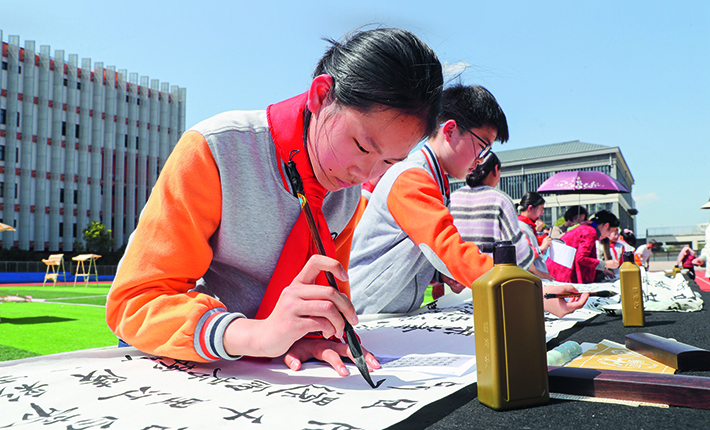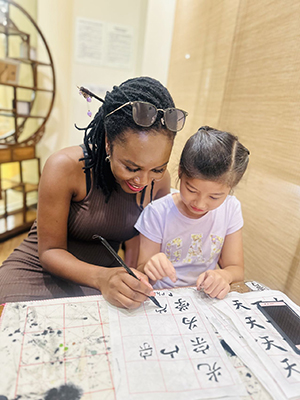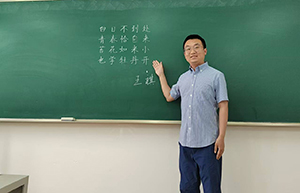|
||||||||||
| Home Top News Economy/Tech Culture/Sports China in Foreign Eyes Green Development Videos Intangible Cultural Heritages |
|
||||||||||
| Home Top News Economy/Tech Culture/Sports China in Foreign Eyes Green Development Videos Intangible Cultural Heritages |
| ChinAfrica |
| Double Take | Handwriting |
| The Double Take column looks at a single topic from an African and Chinese perspective. This month we discuss the significance of handwriting in the digital era. |
| VOL. 16 December 2024 ·2025-01-07 |

China’s Ministry of Education recently announced a new initiative to promote the teaching of standard Chinese handwriting in primary and secondary schools. The objectives of the initiative include teaching students proper writing and pen-holding postures and helping them understand the cultural and historical significance of Chinese characters. The move has triggered discussions on whether it is necessary to learn handwriting in a world where technologies can do most of the writing for us.

It Remains Essential
Katrina Jacob
A 31-year-old Namibian public relations officer
When I heard about China’s push to teach standard Chinese handwriting in primary and secondary schools, I couldn’t help but think: in a world where tech does most of our writing, is this even necessary, especially in a populous, technologically advanced nation like China? But then I thought about what handwriting means - this focus on handwriting resonates deeply, as it represents more than just a skill; it’s linked to identity, culture, and community.
Growing up, handwriting was our primary means of recording everything important. I remember watching my grandmother carefully jot down community meeting notes and compose songs, and even writing her own eulogy, filling page after page with a beautiful handwriting and wisdom that no smartphone app could ever capture in quite the same way.
In school, handwriting lessons taught us more than letter formation - they taught us precision, patience, and pride in one’s work. Our teachers insisted on neatness, not just for presentation but as a way of instilling respect for the task at hand. Those values stay with me today.
In many parts of Namibia, where devices are still scarce, handwriting is still the primary tool for learning. In these settings, writing by hand isn’t outdated - it’s essential. Many children rely on it as their only way to express themselves and preserve their experiences, giving them a voice and a tangible connection to their stories.
China’s initiative serves as a reminder that handwriting grounds us in ways that digital tools cannot. By keeping this practice alive, we honour the voices of those who came before us, embracing the future without forsaking the past. Handwriting, in its quiet and steady way, reminds us of where we came from, while also guiding us to where we’re going. It offers something that technology simply cannot replicate - an authentic, personal touch. Studies show that writing by hand engages the brain differently, enhancing memory retention and sparking creativity. It’s not just about putting words on paper; it’s about connecting with our thoughts and expressing them in a way that feels deeply personal and uniquely our own.

A Tool for Cultural Inheritance and Exchange
Wang Qi
A 31-year-old Chinese Ph.D. student
As someone who has practiced calligraphy since childhood, this art of writing Chinese characters has become an essential part of my life, offering me countless benefits. It is both a way to express myself and a means to cultivate inner discipline.
It is also a tool for cultural exchange. Mastering this ancient craft has given me the unique opportunity to become a cultural bridge between China and Africa. After completing my master’s degree, I began working as an advisor to international students. During an exchange programme for African students, I thought of introducing African students to Chinese calligraphy. I meticulously demonstrated the correct brush-holding posture and carefully explained each fundamental stroke, using bilingual resources to help them to understand both the techniques and the reasoning behind them.
Through this experience, I came to appreciate the depth and difficulty of teaching calligraphy, realising how challenging it must have been for my own teacher all those years ago. This journey has deepened my admiration for the profound world of calligraphy, which still holds endless mysteries for me to explore.
Today, my calligraphy teacher continues to teach it to international students at a university in my hometown. Every holiday, I return to visit him, reflecting on the lifelong influence he has had on me. China’s uniqueness lies in its continuous cultural heritage spanning 5,000 years, with Chinese characters and the art of writing them being central to this heritage. In an age where handwriting is increasingly replaced by digital media, China’s emphasis on standardised handwriting in schools is crucial for preserving and promoting its cultural heritage.
I also hope that these African students will remember me and Chinese calligraphy years from now. Cultural exchange is about learning from one another’s rich traditions and enhancing our own cultural understanding. As a pillar of Chinese culture, calligraphy is worth exploring, and I believe that it will leave a lasting impact on those who study it, just as it has shaped my own life.
| About Us | Contact Us | Advertise with Us | Subscribe |
| Copyright Beijing Review All rights reserved 京ICP备08005356号-5 京公网安备110102005860号 |